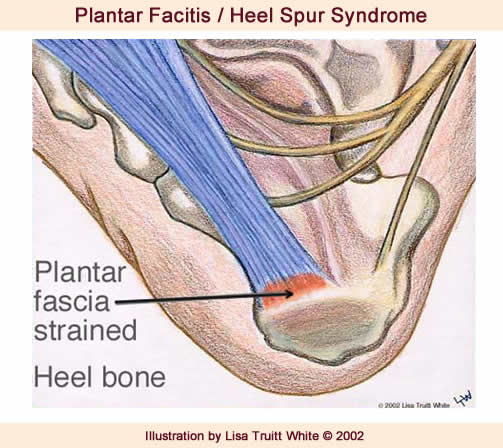Heel pain is the most common problem that brings people to a foot doctor’s office. While many conditions can cause foot pain, there are two that occur most frequently:
-
- Plantar Fasciitis (fah shy tis)
- Posterior Heel Pain
Plantar Fasciitis
- Do you wake up in the morning and dread the thought of putting your foot on the floor because you know your heel will be painful?
- Do you dread standing up after sitting for awhile?
- Does this pain tend to ease as you start to walk around?
- Does your heel hurt more as the day progresses?
If you answered yes to some or all of these questions, you may have plantar fasciitis. The plantar fascia is a thick band of supportive tissue that begins on the bottom of the heel and runs toward the toes. This fibrous band helps to stabilize and support your foot when you are standing, walking, or running.

Why Does the Plantar Fascia Become Painful?
Pain develops when the fibers of the fascia become stretched or develop small tears. This occurs for many reasons. Examples include:
- Increasing activity levels too fast. For instance, beginning a new running or walking program, but doing too much too soon and not gradually increasing the distances run or walked.
- Wearing shoes that are not supportive enough.
- Wearing worn out shoes to exercise or when working in your yard.
Plantar Fasciitis Treatment
Treating plantar fasciitis in the early stages usually allows for a quicker recovery. Left untreated, this condition can progress to the point where there is pain with each and every step. This typically means a return to a pain free day will take much longer.
Initial treatments are aimed at reducing stress on the fascia so it can begin to heal. Also, treatment to reduce the associated inflammation is started. These treatments can often include: ice therapy, anti-inflammatory medications, stretching exercises, wearing shoes with appropriate support, taping of the foot and the use of a night splint.
If these interventions do not lead to a full resolution, custom shoe inserts, cortisone injections, and additional treatment by a physical therapist are often utilized. For patients that fail to respond to all of these efforts, surgical release of the plantar fascia can be a very effective course of action. The good news is this: 95% of the time plantar fasciitis can be fully resolved without the need for surgery.
EPAT, or shockwave therapy, is a relatively new treatment that has been shown to be effective 75% of the time or greater in patients that continue to have pain despite extensive non-surgical treatment. EPAT has also shown excellent results when used in early phases of the treatment process.
Posterior Heel Pain
The Achilles tendon attaches the calf muscles to the back of the heel. This large tendon converts the pull of the calf muscle into foot motion. Unfortunately, this tendon’s attachment to the back of the heel is a common cause of pain.
If there is a lack of flexibility in the calf muscle, too much tension is placed on the Achilles tendon. In some cases this leads to Achilles tendonitis with pain in the tendon above where it inserts onto the heel bone. In many cases, this lack of flexibility causes injury where the tendon attaches. The tendon insertion can become inflamed and thickened. Often, bone spurs will develop. Additional bone may grow within the tendon.
Posterior Heel Pain Symptoms
Initially, this pain may only be present when first standing up after sleeping or sitting. As you walk around, the muscle and tendon loosen and the pain goes away. As this problem progresses, the pain can be present with all standing and walking. You may notice a knot or bump on the back of the heel. Swelling may develop. In some cases, pressure from the back of the shoe causes pain.
Posterior Heel Pain Treatment
Curing posterior heel pain requires calming the inflammation, resting the foot and increasing calf flexibility. Ice therapy and anti-inflammatory medications can be used to reduce the inflammation. Stopping exercises that stress the calf and Achilles is important. This includes walking, running and the use of stair climbers and elliptical machines.
Placing a heel lift in each shoe can reduce some of the excess strain on the back of the heel. Stretching exercises to increase calf flexibility are important in curing this problem and preventing its recurrence. Wearing running shoes also provides good foot support and helps with this condition. Sometimes a walking boot is used to immobilize the ankle and let the area completely rest. Physical therapy is sometimes ordered to help reduce the inflammation and pain and to help improve the flexibility of the calf muscles.
Occasionally these measures fail to relieve the pain and surgery may be needed. The surgical procedure involves removing bone spurs and repairing any damage to the tendon.
We Help People with Heel Pain
Although there are many causes of heel pain, plantar fasciitis and posterior heel pain are the two most common. Ignoring heel pain usually leads to a worsening situation. If you have heel pain, call us at (317) 573-4250. The doctors at Indy Podiatry are experts in the treatment of plantar fasciitis and posterior heel pain.
